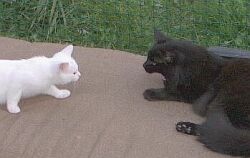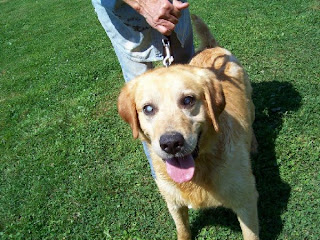As pets are living longer and are viewed as furry family members, dental care is becoming an increasingly important part of veterinary care. Aside from causing terrible breath, the oral bacteria associated with plaque enters the bloodstream and travels throughout the body to cause disease in the liver, kidneys, heart, brain, and elsewhere! Moreover, severe dental disease (bleeding gums, loose teeth, abscess) is known to be painful and decreases a pet's quality of life. Most owners don't recognize this change in their pet until after the pet has healed from a dental procedure. Then many report their dog or cat is acting like a puppy or kitten again!
As with most medical conditions prevention of dental disease is preferable to treatment. Regular tooth brushing is the best prevention. No, crunchy dry food is not going to do it. (If you ate nothing but carrots and corn flakes you would still need to brush your teeth and see your dentist!) Dogs and cats can learn to enjoy tooth brushing as a special treat or bonding time with you...ask your veterinarian for suggestions on how to do this. Certain treats and chewies will help reduce tartar, but some, like real bones, can actually break teeth so again check with your veterinarian. There are many gels, sprays and water additives available through your veterinarian that can also help reduce the disease-causing bacteria in your pet's mouth. And for dogs there is an annual dental vaccine!
Like people most dogs and cats over the age of 3 would benefit from preventative dental cleanings (yep, under sedation) at least once a year. Very small dogs (e.g., Yorkies, Maltese, Chihuahuas, etc.) ideally would have cleanings twice a year!
Some owners bring their pets in for dental cleaning and request that the veterinarian "not pull any teeth unless absolutely necessary." Oh, boy. Obviously, these people have never had to extract a fractured and painful but not yet abscessed and mobile tooth before. It is no walk in the park. Nope, veterinarians (the ones I know at least) would never extract a non-diseased tooth just to rack up the final bill! Really, it's not worth the effort.
 |
| The goal is to AVOID needing this many extractions! However, this dog undoubtedly feels better without the chronic toothache these diseased teeth caused! |
If you've been told your dog or cat needs a dental procedure, here are some questions to ask your veterinarian:
1. Will my pet have pre-anesthetic blood testing done?
2. Do you expect my pet will need any extractions?
3. If my pet has extractions, what kind of medications will s/he go home with (pain relievers, antibiotics)?
4. What can I do at home after the dental procedure to keep my pet's mouth healthy?
5. Can I get an estimate for the dental procedure?
February is National Pet Dental Health Month. With the winter holidays behind us by then, February is the perfect time to focus on getting your furry family member scheduled for dental assessment and/or treatment!
































